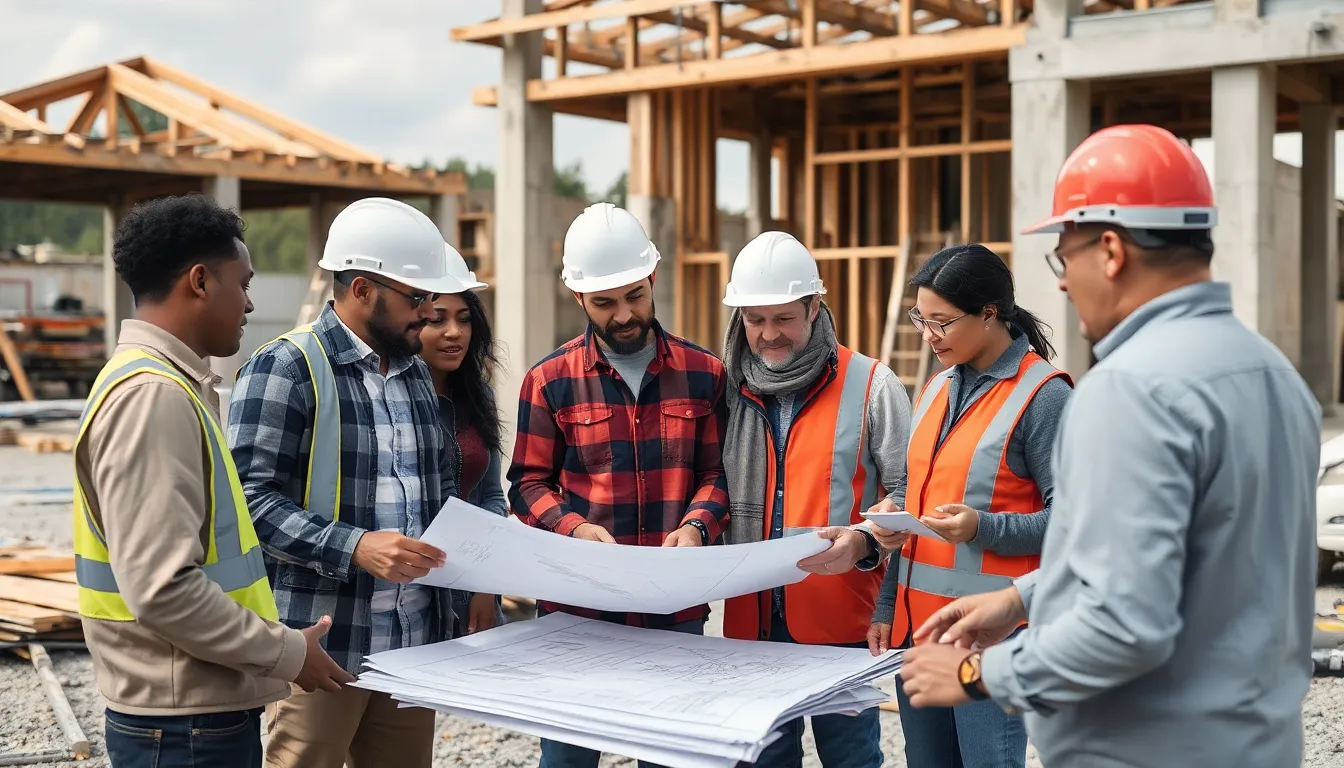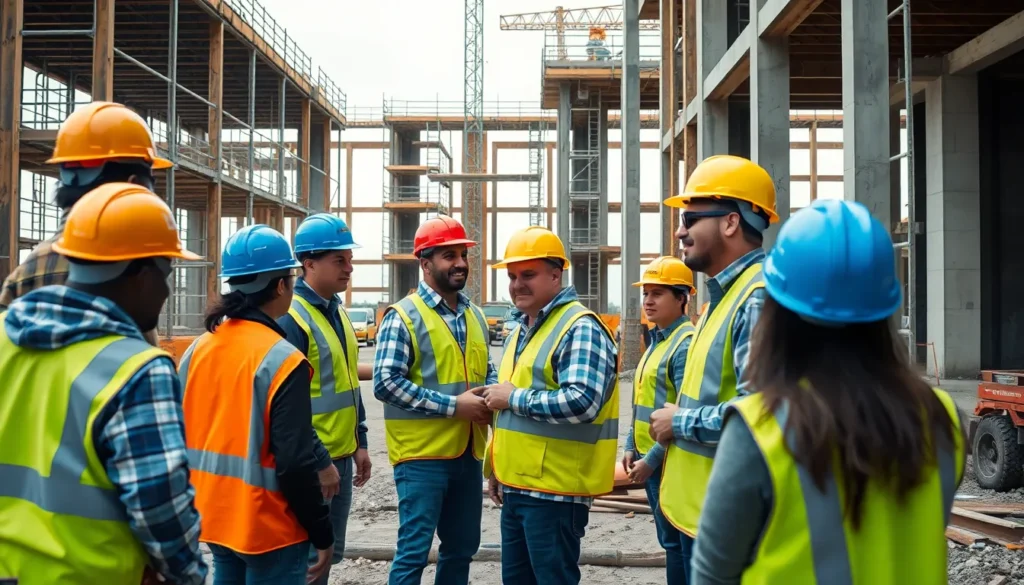Table of Contents
ToggleBuilding construction isn’t just about bricks and mortar; it’s the art of transforming dreams into reality. Whether it’s a cozy cottage or a towering skyscraper, every structure tells a story. And let’s face it, who hasn’t daydreamed about their perfect home or the next big architectural marvel?
Overview of Building Construction
Building construction encompasses various processes that bring architectural visions to life. It serves as a platform for creativity, transforming designs into tangible structures. The process begins with planning, which involves site analysis, obtaining permits, and establishing budgets. These steps lay the foundation for successful execution.
Structural elements form the backbone of any building. Components like beams, columns, and walls work in tandem, ensuring stability and durability. Material selection plays a crucial role in construction, with options ranging from traditional wood and brick to modern steel and concrete. Each material possesses unique properties that affect the overall design and function.
Construction techniques also vary depending on the project scope. Methods like modular construction expedite timelines by allowing prefabrication of elements off-site. In contrast, traditional on-site methods might offer more customization opportunities. Skilled labor drives the construction process, with architects, engineers, and tradespeople collaborating seamlessly.
Safety stands as a priority throughout building construction. Adhering to strict regulations ensures the well-being of workers and future occupants. Regular inspections help maintain quality standards, mitigating risks associated with structural failures.
Sustainability is becoming increasingly important in construction. Incorporating energy-efficient systems and eco-friendly materials reduces environmental impact. Green building practices not only benefit the planet but also lower operational costs for owners.
Building construction involves multiple interconnected elements. From planning and material selection to safety protocols and sustainability, each aspect contributes to the creation of functional and aesthetically pleasing structures. These efforts reflect society’s evolving aspirations in architecture and design.
Key Stages in Building Construction

Building construction consists of several critical stages, each contributing to the overall success of the project. Understanding these stages helps ensure smooth execution and desired results.
Planning and Design
Planning and design form the foundation of any construction project. Architects collaborate with clients, translating ideas into detailed blueprints. Prioritizing functionality and aesthetics, this stage involves selecting materials that blend durability with style. It’s essential to incorporate local building codes and regulations early in the process. Thorough assessments determine project feasibility, including budgets, timelines, and potential challenges. Engaging stakeholders at this stage fosters better communication throughout the construction phases. Ultimately, a well-structured plan sets clear expectations and paves the way for efficient progress.
Site Preparation
Site preparation is crucial for creating a safe and efficient working environment. It begins with clearing the land of debris and vegetation, allowing for an unobstructed workspace. Contractors assess the site’s topography to identify necessary grading and drainage solutions. Implementing proper drainage systems prevents water accumulation and potential future issues. Utilities such as water, electricity, and sewage require strategic planning during this stage. Establishing a solid foundation demands attention to soil types and stability, ensuring the structural integrity of the building. Successful site preparation directly impacts the smooth progression of the construction project.
Materials Used in Building Construction
Building construction relies on a diverse range of materials tailored for specific purposes. Selecting appropriate materials affects durability, aesthetics, and sustainability.
Structural Materials
Concrete stands as one of the most popular structural materials. Its strength and versatility make it suitable for foundations, walls, and floors. Steel also plays a crucial role, providing robustness for frameworks and support beams. Wood remains a traditional choice for residential buildings, valued for its accessibility and insulation properties. In addition, masonry units such as bricks and blocks contribute to stability and fire resistance. Each structural material emphasizes durability and load-bearing capabilities, which are vital for safe construction.
Finishing Materials
Finishing materials enhance both functionality and aesthetics within a building. Drywall serves as a key component for interior walls and ceilings, offering an easy surface for painting or wallpapering. Flooring options, including tiles, hardwood, and carpeting, create inviting spaces tailored to various styles. Paint provides an ideal finish for walls and ceilings, enabling personalization through color and texture. Fixtures, such as lighting and hardware, further add character and enhance usability. Each finishing material plays an essential role in transforming raw spaces into complete environments, ensuring visual appeal and comfort.
Construction Techniques and Methods
Understanding construction techniques and methods is essential in building construction. These techniques significantly impact project efficiency, durability, and aesthetic appeal.
Traditional Methods
Traditional methods encompass techniques that have been used for centuries. Masonry involves the assembly of materials like brick, stone, and concrete blocks to create structures. These materials provide durability and weather resistance. Carpentry methods emphasize wood framework for house construction, utilizing the material’s versatility and natural aesthetic. Additionally, plastering techniques apply finishes to walls and ceilings, enhancing both insulation and appearance. Traditional craftsmanship relies heavily on skilled labor, ensuring quality and attention to detail.
Modern Techniques
Modern techniques focus on innovation and efficiency. Prefabrication allows for components to be manufactured off-site, reducing construction time on-site. This method promotes precision and reduces waste by using advanced technologies. 3D printing emerges as a revolutionary method, enabling radical design possibilities and material savings. Also, modular construction segments buildings into manageable sections, enhancing flexibility and scalability. Advanced safety protocols and tools facilitate on-site construction, prioritizing worker safety and productivity. These modern techniques emphasize sustainability, integrating eco-friendly materials and energy-efficient designs into the construction process.
Challenges in Building Construction
Building construction faces various challenges that can affect the project’s success. Two notable issues include cost overruns and time delays.
Cost Overruns
Cost overruns frequently occur during building construction projects. Budgeting inaccuracies often lead to unexpected expenses, impacting financial plans. Material price fluctuations can also contribute to rising costs, especially for commodities like steel and wood. Poor project management may exacerbate these issues, as inefficient resource allocation can drain funds quickly. To mitigate risks, accurate cost estimation and continuous monitoring are essential strategies for staying within budget.
Time Delays
Time delays represent another significant challenge in construction. Unforeseen weather conditions can halt progress, prolonging project timelines. Additionally, permitting issues may arise, causing setbacks in starting or completing phases of construction. Labor shortages are another factor that can delay progress, with skilled labor becoming increasingly difficult to find. Effective scheduling and communication help minimize potential delays, ensuring projects remain on track for timely completion.
Building construction is a multifaceted endeavor that combines creativity with technical expertise. It transforms visions into tangible structures that serve communities and individuals alike. By prioritizing safety and sustainability, the industry can adapt to modern challenges while meeting the demands of future generations.
The collaboration among architects, engineers, and skilled tradespeople is vital for successful outcomes. As construction techniques evolve, embracing innovative methods and materials will enhance efficiency and reduce environmental impact. This commitment to quality and sustainability ensures that every project not only meets today’s standards but also contributes positively to the world around us.








